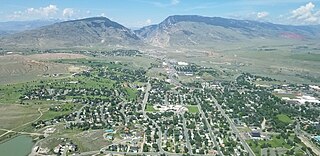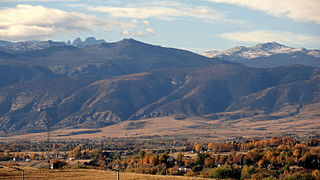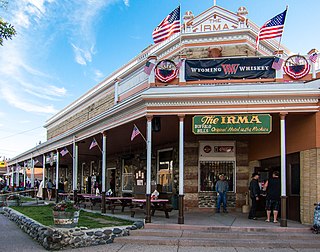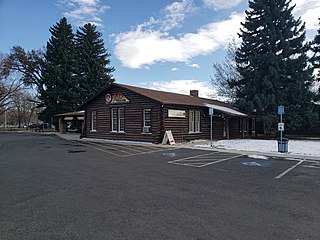
Cody is a city in Northwest Wyoming and the seat of government of Park County, Wyoming, United States. It is named after Buffalo Bill Cody for his part in the founding of Cody in 1896.

Sheridan is a town in the U.S. state of Wyoming and the county seat of Sheridan County. The town is located halfway between Yellowstone Park and Mount Rushmore by U.S. Route 14 and 16. It is the principal town of the Sheridan, Wyoming, Micropolitan Statistical Area which encompasses all of Sheridan County. The 2010 census put the town's population at 17,444 and the Sheridan, Wyoming, Micropolitan Statistical Area at 29,116, making it the 421st-most populous micropolitan area in the United States.

William Frederick Cody, known as "Buffalo Bill", was an American soldier, bison hunter, and showman. He was born in Le Claire, Iowa Territory, but he lived for several years in his father's hometown in modern-day Mississauga, Ontario, Canada, before the family returned to the Midwest and settled in the Kansas Territory.

Gertrude Vanderbilt Whitney was an American sculptor, art patron and collector, and founder in 1931 of the Whitney Museum of American Art in New York City. She was a prominent social figure and hostess, who was born into the wealthy Vanderbilt family and married into the Whitney family.

Charles Marion Russell, also known as C. M. Russell, Charlie Russell, and "Kid" Russell, was an American artist of the American Old West. He created more than 2,000 paintings of cowboys, Native Americans, and landscapes set in the western United States and in Alberta, Canada, in addition to bronze sculptures. He is known as "the cowboy artist" and was also a storyteller and author. He became an advocate for Native Americans in the west, supporting the bid by landless Chippewa to have a reservation established for them in Montana. In 1916, Congress passed legislation to create the Rocky Boy Reservation.

The Irma Hotel is a landmark in Cody, Wyoming. It was built by William F. "Buffalo Bill" Cody, the city's co-founder and namesake who named it after his daughter Irma Cody. A focal point is a famous back bar made of cherry that was a gift given by Queen Victoria to Buffalo Bill.

The Buffalo Bill Center of the West, formerly known as the Buffalo Bill Historical Center, is a complex of five museums and a research library featuring art and artifacts of the American West located in Cody, Wyoming. The five museums include the Buffalo Bill Museum, the Plains Indians Museum, the Whitney Western Art Museum, the Draper Natural History Museum, and the Cody Firearms Museum. Founded in 1917 to preserve the legacy and vision of Col. William F. "Buffalo Bill" Cody, the Buffalo Bill Center of the West is the oldest and most comprehensive museum complex of the West.

Buffalo Bill Ranch State Historical Park, known as Scout's Rest Ranch, is a living history state park located west of North Platte, Nebraska. The ranch was established in 1878 with an initial purchase of 160 acres south of the Union Pacific tracks by William Cody. The 4,000 acre ranch was sold in 1911 and has been under the management of the Nebraska Game and Parks Commission since 1964. The 25 acre historic state park, added to the National Register of Historic Places in 1978 and designated a National Historic Landmark in 2021, is open weekdays from April to October. The house and outbuildings can be toured, including a museum documenting Cody's life from a Pony Express rider to his Wild West shows.
Harold McCracken (1894–1983) was an American writer, Alaskan grizzly bear hunter, biplane stunt photographer, cinematographer, producer and museum director. He was a noted explorer, who led expeditions in the 1920s tracing the possibility of a long-ago land bridge between Siberia and Alaska.

Lookout Mountain Park is a Denver Mountain Park located around 12 miles (20 km) west of downtown Denver overlooking Golden, Colorado. It consists of 65.7 acres (266,000 m2) of evergreen wilderness atop Lookout Mountain, named for its being a favored lookout point of the native Ute Indian tribe. Lookout Mountain Park is the burial site of the internationally famous western frontiersman William Frederick "Buffalo Bill" Cody, and is listed on the National Register of Historic Places.

The following is an alphabetical list of articles related to the U.S. state of Wyoming.

The Buffalo Bill Boyhood Home was built by Isaac Cody, the father of Buffalo Bill Cody in 1841 at LeClaire, Iowa. The house was purchased as a tourist attraction by the Chicago, Burlington and Quincy Railroad and was moved to Cody, Wyoming, Buffalo Bill's adopted hometown, in 1933.

The Downtown Cody Historic District is the historic core of Cody, Wyoming, USA. "Historic" here refers to the early twentieth century, as Cody was not incorporated until 1901. Most of the commercial district was built between 1901 and the 1930s. The district extends along Sheridan Avenue for two blocks, with buildings of brick and local sandstone with storefront display windows. The chief building in the district is the Irma Hotel, individually listed on the National Register of Historic Places.

The Stock Center in Cody, Wyoming, United States, was built in 1927 as the original home of the Buffalo Bill Museum, serving in that purpose until the museum was relocated to a new complex across the street in 1969. The log structure is intended to suggest a stockman's log cabin, rendered on a large scale.

The Paul Stock House was the residence of three-time Cody, Wyoming mayor, oilman, rancher and philanthropist Paul Stock. Built in 1945–46, the house is on a secluded site on a bluff overlooking the Shoshone River, with a view of Heart and Cedar Mountains on the edge of Cody. The house was designed by Leon Goodrich, who was fired after two months because Stock didn't want to be told what to do by the architect. Stock took over the management of the project from then on, building the rambling house in the Spanish Eclectic style. While Stock oversaw the project himself, he kept nearly all of Goodrich's design intact.
Thomas C. Molesworth (1890–1977) was an American furniture designer who was a significant figure in the creation of a distinctly Western style of furniture and accessories, using hides, horn and natural wood. Molesworth's style drew from the Arts and Crafts Movement and from vernacular design characteristics of western American ranches and farms. He is credited with popularizing the "cowboy furniture" style. To produce his designs, Molesworth operated the Shoshone Furniture Company from 1931 to 1961 in Cody, Wyoming with his wife, LaVerne Johnston Molesworth.

Trail End, also known as the John B. Kendrick Mansion, is a historic home located at 400 Clarendon Avenue in Sheridan, Wyoming. The home was built and inhabited by Wyoming governor and U.S. Senator John B. Kendrick. Built from 1908 to 1913, the house was designed by Glenn Charles MacAlister and cost $164,000. Kendrick was a successful cattleman when he commissioned the house, and he was only beginning his political career; once he became governor in 1914 and a senator three years later, Trail End became his summer home. The house is typical of homes built by prosperous Wyoming cattlemen in the early 20th century. It was added to the National Register of Historic Places on February 26, 1970.
Harry Andrew Jackson, born Harry Aaron Shapiro Jr., was an American artist. He began his career as a Marine combat artist, then later worked in the abstract expressionist, realist, and American western styles.
Peter M. Fillerup was an American sculptor. A member of the Church of Jesus Christ of Latter-day Saints, he attended Brigham Young University–Idaho and Brigham Young University in Provo. He was trained by Utah sculptor Avard Fairbanks. He designed a sculpture of Porter Rockwell, who served on the Council of Fifty, as well as lighting fixtures for 20 LDS temples, including the Payson Utah Temple and the Lima Peru Temple. In 1997, he designed the Hilda Erickson Memorial Statue, a public statue in memory of all American pioneers in Grantsville, Utah.

















